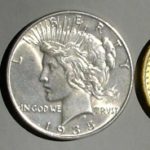Gold rose to the highest since the beginning of October after the U.S. Labor Department reported that U.S. non-farm payrolls rose at the slowest rate in four years in September, reinforcing broad expectations that the Federal Reserve will refrain from trimming its bond purchasing program this year. The U.S. dollar fell to an 8-1/2 month low.
On the Comex division of the New York Mercantile Exchange, gold futures for settlement in December rose by 1.01% to $1 329.10 per troy ounce at 13:25 GMT. Prices surged to a session high of $1 334.90 minutes after the release of the employment data, the strongest level since October 1, while days low was hit at $1 310.10 per ounce. The precious metal fell by 0.1% on Monday and extended its weekly advance to over 1% on Tuesday.
Gold was shot up as the U.S. dollar plunged to an 8-1/2 month low after the U.S. Department of Labor reported that the U.S. economy added 148 000 jobs in September, sharply underperforming a median forecast of 93 economists surveyed by Bloomberg for a 180 000 surge. Augusts reading received an upward revision to 193 000 payrolls from initially estimated at 169 000, signalling that the U.S. labor market lost momentum prior to the 16-day government shutdown. This added to previous speculations that the Federal Reserve will delay scaling back its bond purchases until some point in 2014.
The U.S. unemployment rate, based on a separate Labor Department survey of households, fell by 0.1% to 7.2% in September, beating expectations to remain flat. However, the participation rate, which measures the number of people who are either employed or are actively looking for work, remained the lowest since August 1978 at 63.2%, indicating that the fall in the unemployment rate was based on people who stopped searching for a job.
Private employment, which excludes government agencies, added 126 000 jobs, underperforming projections for a 180 000 advance and last months revised 161 000 payrolls. Full-time hiring rose by 691 000, while part-time employment dropped by 594 000.
Data today also showed that average hourly earnings rose by 0.1% in September, underperforming expectations for a 0.2% increase and last months upward revised 0.3% advance. Americans working week remained unchanged at 34.5 hours.
The data added to piling expectations that the Federal Reserve will hold back from scaling down its monetary stimulus. Todays report included the pay period up to the 12th of September, excluding information about the government shutdown and its consequences. Policy makers will have to wait several months to receive reliable and revised data, on which to base its decisions.
A senior Federal Reserve official said on Monday that it will be tough for the central bank to take a decision to start scaling back its bond purchases in December, given the lost output during the 16-day government shutdown and the still standing differences between Democrats and Republicans.
Chicago Fed President Charles Evans said for CNBC: “October is a tough one. December? I think we need a couple of good labor reports and evidence of increasing growth, GDP growth. It is probably going to take a few months to sort that one out. It is very difficult to feel confident in December given that we’re going to repeat part of what just took place in Washington.”
The U.S. dollar index, which measures the greenbacks performance against six major counterparts, traded at 79.58 at 13:18 GMT, down 0.20% on the day. The December contract plunged to 79.43 minutes after the release of the data, the lowest since the last week of January, while days high stood at 79.86. The U.S. currency gauge added less than 0.1% on Monday but fell to negative weekly territory after Tuesdays retreat.
Elsewhere on the precious metals market, silver futures for December settlement rose by 1.03% to $22.508 per troy ounce at 13:21 GMT. The metal surged to a one-month high of $22.770 after the jobless report was released, while days low stood at $21.985. Platinum for delivery in January traded at $1 435.80 per ounce, down 0.20%, and shifted in a day’s range between $1 443.60 and $1 426.35. Palladium December futures declined by 0.65% to $745.40 an ounce. The metal surged to session high of $752.10, the strongest level since August 26, while day’s low stood at $742.50 per ounce.





